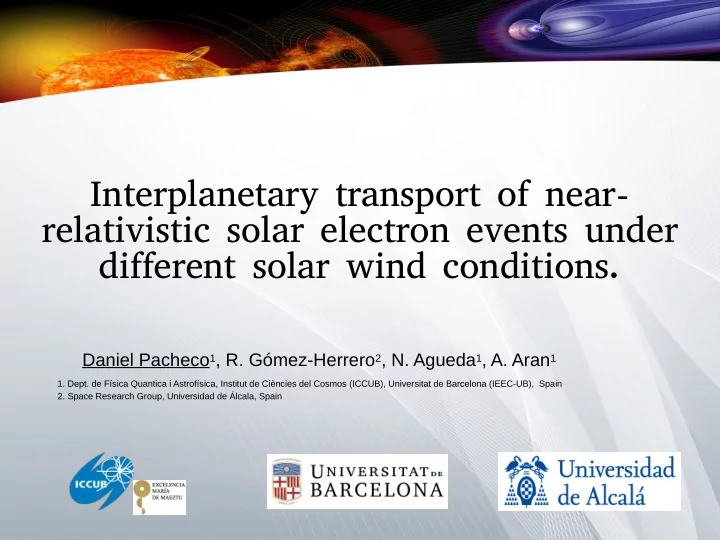

Interplanetary transport of near- relativistic solar electron events under different solar wind conditions. Daniel Pacheco 1 , R. Gómez-Herrero 2 , N. Agueda 1 , A. Aran 1 1. Dept. de Física Quantica i Astrofísica, Institut de Ciències del Cosmos (ICCUB), Universitat de Barcelona (IEEC-UB), Spain 2. Space Research Group, Universidad de Álcala, Spain
OUTLINE 1. Description of the two studied events and motivation 2. Modelling the observed SEP events. 3. Results 4. Conclusions
Events 2014 August 1 Selection Criteria Detected by both STEREOs ➢ Well-connected ➢ Impulsive nature ➢ Stable solar wind conditions ➢ No type II radio burst associated ➢ Klassen et al. (2016)
Events 2014 August 1 The angular peak intensity distribution ➢ does not show the usual Gaussian distribution. They propose as an explanation of their ➢ results a “fingered” spatial peak intensity distribution of SEP events at 1 AU. This could also be is related to different ➢ transport conditions. Klassen et al. (2016) Goal of our study To study if these observations can also be ➢ explained by different transport conditions in the interplanetary medium.
Interplanetary transport model Focused transport equation Roelof (1969) a t 2 s o l a r r a d i i S t a t i c s o u r c e ➢ I d e a l P a r k e r s p i r a l ➢ F o c u s i n g e f f e c t ➢ c a t t e r i n g ( c o n v e c t i o n , d e c e l e r a t i o n ) P i t c h - a n g l e s ➢ N o p e r p e n d i c u l a r d i f u s s i o n ➢ λ r = c o n s t . ➢ Simulation results ➢ Differential intensities of electrons at 1 AU as a f u n c t i o n o f t i m e , p i t c h a n g l e a n d e n e r g y . ➢ For an instantaneus injection at the Sun. Agueda et al. (2012)
Inversion SEPInversion software ➢ Release time history ➢ Interplanetary transport contiditons Procedure ➢ Inversion approach ➢ Angular response of the detectors included ➢ 25 values of the radial mean free path (0.05-2.77 AU) Results ➢ Deconvolution of the effects of interplanetary transport ➢ Each channel fitted separately ➢ Best possible release time history and λ r inferred Agueda et al. (2008,2014)
Results Event I Results Event II STEREO A STEREO A Different profiles for each FOV More anisotropic PADs STEREO B STEREO B Similar profiles for each FOV Very isotropic PADs
Injection profiles & transport conditions Event I, STA Event I, STB Event II, STA Event II, STB Best connected! Best connected!
Conclusions ➔ Release is almost simultaneous for both s/c, short in duration (<10 min) and higher for the best connected s/c. ➔ The event starts first for the s/c located inside the less diffusive flux tube. ➔ The characteristics of the transport are different in the different solar wind regimes. ➔ The low particle intensities observed by STB at 1 AU can be explained by more turbulent conditions (lower value of the mean-free path).
Thank you for your attention! Contact: dpacheco@ub.edu Acknowledgements This work was performed under the Spanish Project AYA2013-42614-P.
Recommend
More recommend